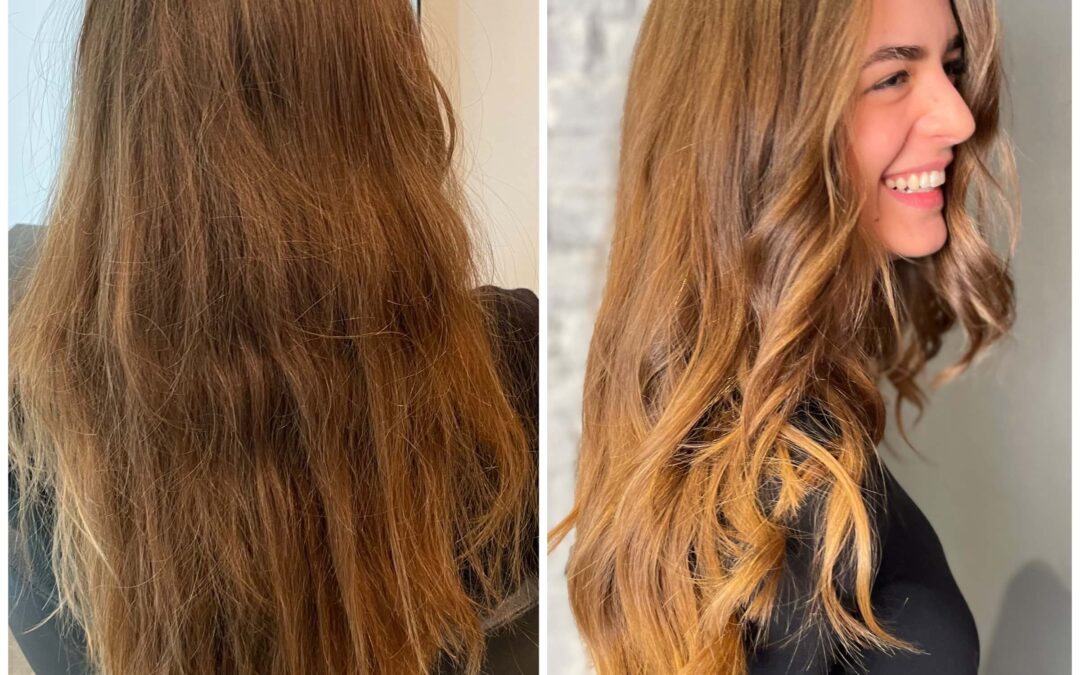Kieselbach, your hairdresser in Berlin Mitte, invites you to discover and explore the fascinating history of Balayage, a hair coloring technique that has permanently revolutionized the world of hair dye and delighted customers worldwide.
BALAYAGE – ORIGIN OF THE WORD
The Balayage technique, a term derived from the French verb “balayer,” meaning “to sweep,” has progressively conquered the world of hair coloring and is now one of the most popular methods of hair dyeing in many countries.
This method, which first emerged in France in the 1970s, focuses on hairdressers applying hair color by hand and only partially on the hairs, instead of treating the entire head of hair, including the hair roots, with color.
Balayage deliberately avoids the roots of the hair, leaving this part of the hair untreated by the dye, thus sparing the scalp and achieving a maximally natural look.
Unlike more traditional coloring techniques such as foil highlights or cap highlighting, the Balayage technique allows hairdressers to achieve a more natural-looking hair color for their clients, giving the impression that the coloring has naturally occurred as if kissed by the sun. This creates a seamlessly flowing transition from the darker natural hair to the lighter Balayage-treated lengths and ends.
ORIGINS AND DEVELOPMENT OF THE BALAYAGE TECHNIQUE
Balayage began as an artistic technique for coloring hair strands in the exclusive salons of Paris. Hairdressers in the French capital gradually developed a sense for color and shape by applying hair color with brushes and hands instead of relying on preformed tools. This manual method allowed for a more individual, tailored coloration that adapted to the natural hair structure and fall.
Unlike largely uniform highlights/strands achieved using a cap or foil technique, the Balayage technique creates optically softer and less predictable patterns.
This results in an effect that resembles the natural play of light in the hair after a summer at the beach – hence the coined term “sun-kissed” in relation to Balayage coloring techniques.
This technique was appreciated from the beginning for its ability to place hair color in a way that harmonizes with natural hair growth, offering less obvious regrowth issues.
The “natural” highlights created by Balayage lead to visually more movement and volume in the hair due to the varied light hair colors.
GLOBAL SPREAD AND POPULARITY OF BALAYAGE
For some years, the Balayage technique initially spread throughout France from Paris, and it wasn’t until the 1990s that this new hair coloring technique began to spread worldwide.
Simultaneously, with the rise of supermodels and the influence of celebrities from the fashion industry since the 1990s, women across the Western world began seeking more natural, individual looks, emulating their idols from the fashion world.
Balayage, with its ability to create tailored, flowing highlights, perfectly matched this trend, so that the triumph of this technique continued progressively.
With the advent of social media and platforms such as Facebook, Instagram, and Pinterest, which made it incredibly easy for consumers to share images and videos with each other, the popularity of Balayage reached new heights.
Hairdressers and their clients eagerly shared before-and-after pictures, showcasing the subtle but effective results of this technique.
Today, Balayage has not only become a lasting trend worldwide but has also developed into an established hair coloring technique offered in salons all over the world.
For this purpose, the classic Balayage technique is continuously being developed and combined with foil for more brightness, the Airtouch technique, or the Toupee technique, and with the Route Shadow technique for more dimensions in the hair. You notice here, thoughtful combining of techniques leads to the best result.
TERMS AND EXPLANATIONS Balayage:
A hair coloring technique where color is applied freehand to achieve a natural-looking, sun-kissed effect. Airtouch: shorter intermediate hairs are blown out using a hairdryer before the product is placed. Toupee: shorter hairs are pushed back towards the roots with the help of a comb to create a softer gradient of color. Highlights: Strands of hair that are dyed lighter than the base color to create depth, dimension, and movement. Foil technique: A method where strands of hair are wrapped in foil after the color has been applied to increase color intensity and achieve a more even distribution. Route Shadow: Glossing in at least 2 different shades is applied. For example, a darker tone at the roots and a lighter one for the lengths and ends. Cap Highlighting: An older technique where a cap with holes is placed on the head, through which strands are pulled and then dyed.
SUMMARY OF THE HISTORY OF BALAYAGE
From its humble beginnings in Parisian salons in the 1970s to its current global popularity, Balayage has established itself as a permanent technique in the world of hair coloring.
The Balayage technique not only offers a personalized coloration precisely tailored to the head hair, highlighting the natural beauty of the hair, but also provides a gentler alternative to traditional methods, with less visible regrowth and generally less maintenance required.
Balayage remains the preferred choice for those seeking a soft, natural look with depth and color dimension.
The natural Balayage highlights are compatible with almost any hair color and can be individually tailored to any hair type just for you.
As always, hair quality comes before the result, and your hair is as unique as you are.
I’m Anja, feel free to consult or book your Balayage here.
HAIRCOLOR WITH ATTITUDE

